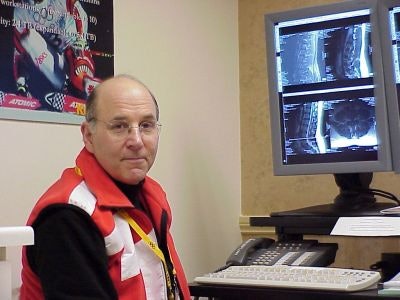
SALT LAKE CITY - It may have been the first time Dr. Mark Kransdorf had met the 27-year-old speed skater, but after reading her MR exam at the Olympic Polyclinic, he instantly knew more about her injury history than even she did.
"She had evidence of multiple small fractures because there was some deformity (in the wrist), but she really didn’t remember any specific injury. I’m sure it’s just a compilation of multiple smaller injuries that she just (dealt with) because she didn’t have time to take off from training," said Kransdorf.
Athletes have learned quite a bit about old injuries this past week, according to Kransdorf, who spends most of his time as chief of the musculoskeletal section at the Mayo Clinic in Jacksonville, FL.
 |
| Dr. Mark Kransdorf of the Mayo Clinic in Jacksonville, FL, wrapped up his weeklong shift at the Olympic Polyclinic on Sunday. |
Kransdorf wrapped up his weeklong stay as a visiting radiologist at the Polyclinic on Sunday. He pulled his shift at the Polyclinic before the 2002 Olympic Winter Games officially began, so most of the injuries he imaged were chronic or recurring aches and pains sustained during practice.
Injuries ranged from minor to serious. A 36-year-old woman complained of mild back pain. A hockey player relied on Kransdorf and the consulting orthopedists at the Polyclinic to tell him whether he would be able to play, or whether he had to sit the Games out while a replacement was flown in from Europe.
"We had one particular young skier who had an ACL (anterior cruciate ligament) injury a few weeks ago. He’d undergone a rapid change in symptoms over the last few days. We took a look and he had torn his meniscus on top of that," Kransdorf said.
Kransdorf worked mostly with the 1.5-tesla Signa Infinity MR scanner (GE Medical Systems) that is installed at the clinic. And even if patients were a bit sketchy on the details of past mishaps, Kransdorf appreciated knowing that almost-complete access to the patient’s history was available at the Polyclinic.
"What’s very nice about it is that when you image the athletes, either the team physician or the coach is there while you are doing it so they have the full clinical history," he explained. "If you see something that’s abnormal, they can give you the clinical history. In these high-caliber athletes, that’s important to have."
By Shalmali Pal
AuntMinnie.com staff writer
February 11, 2002
Copyright © 2002 AuntMinnie.com


















